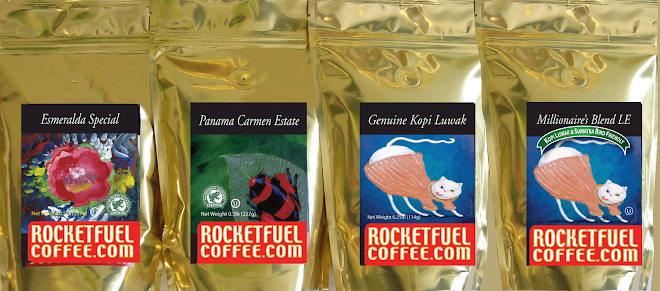Fair, Organic, Direct, and Bird Friendly Coffee... Just what is in your cup?
Today a leader in the Canadian coffee community, Poul Mark, owner of Transcend Coffee, asked his website and blog visitors what they thought of direct trade coffee practices. What does it mean to you, is it a useful distinction, does it have any meaning at all in your world as a coffee consumer or professional? These are important and fascinating questions, and could actually also apply to fair trade and other coffee terms. Then it hit me. First you would have to understand what these terms mean. Once I explain these terms to my own visitors, maybe they will make better choices too.
Fair Trade:
Fair Trade is an organized social movement and market-based approach that aims to help producers in developing countries obtain better trading conditions and promote sustainability. The movement advocates the payment of a higher price to producers as well as social and environmental standards.
Fair trade certification purports to guarantee not only fair prices, but also the principles of ethical purchasing. These principles include adherence to ILO agreements such as those banning child and slave labour, guaranteeing a safe workplace and the right to unionise, adherence to the United Nations charter of human rights, a fair price that covers the cost of production and facilitates social development, and protection and conservation of the environment. The Fairtrade certification system also attempts to promote long-term business relationships between buyers and sellers, crop prefinancing, and greater transparency throughout the supply chain and more.
Organic (including Shade Grown):
Organic coffee is coffee that has been grown according to organic farming standards and techniques, without the use of artificial fertilizers, pesticides or herbicides. Many producers exclusively use the two main coffee certifications: shade-grown and organic. They do this in an effort to create a more environmentally and socially responsible product as well as to market it to more affluent socially responsible consumers. The term organic can also refer to farms, or products from them which incorporate socially responsible activities such as recycling, composting, soil health and environmental protections.
In order to be sold as organic coffee in the U.S. it must gain organic certification and meet the following requirements:
- Grown on land without synthetic pesticides or other prohibited substances for 3 years.
- A sufficient buffer exists between the organic coffee and the closest traditional crop.
- Sustainable crop rotation plan to prevent erosion, the depletion of soil nutrients, and control for pests.
Direct Trade:
Direct trade is a term used by coffee roasters who buy straight from the growers, cutting out both the traditional middleman buyers and sellers and also the organizations that control certifications such as Fair Trade and Bird Friendly, for example. Direct trade proponents say their model is the best because they build mutually beneficial and respectful relationships with individual producers or cooperatives in the coffee-producing countries. Some roasters do it because they are dissatisfied with the third-party certification programs, while others want to have more control over aspects ranging from the quality of the coffee, to social issues, or environmental concerns. This is a new concept and semi-controversial, as it means companies less involvement by organizations who look out for both consumer and farmer welfare. (Hey, no logo for this one yet!)
Bird Friendly:
Scientists at the Smithsonian Migratory Bird Center have discovered that the connection between birds and coffee helps coffee farmers and the environment.
In 2000, the center launched the shade-grown coffee certification program to promote the growth of sustainable coffee, meaning coffee that is viable economically, environmentally and socio-culturally.
Coffee grown in the shade of tree canopies, rather than on land cleared of other vegetation, provides a habitat for a number of species, including migratory birds such as various species of warblers, vireos, orioles, grosbeaks, hummingbirds, tanagers, and many more. In addition to birds, shade coffee plantations provide habitat for orchids, insects, mammals (such as bats), reptiles, and amphibians.
Despite the benefits involved in the program, the Bird Friendly label has a very small niche in the American coffee market, which is dominated by mass market brands sold in grocery stores. Bird Friendly coffee makes up a small percentage of organic coffees, which account for only about 5 percent of the specialty coffee market.
Bird Friendly, like other specialty coffees, costs a few dollars more per pound than regular coffee, and roasters give 25 cents per pound to the Smithsonian program.
A word about Rare Coffees.
Rocketfuelcoffee.com brings you Specialty Coffees that are often only available once, or for a short time, from a particular place. Whether the coffee is Fair Trade, Organic, Direct Trade or Bird Friendly may not be as relevant as if the coffee is genuine, fresh or available at all. So make your choices wisely and watch for symbols. Most of all, enjoy the coffee that you like best!













